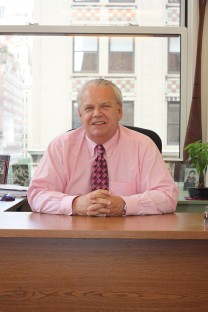VIEWPOINT
The Cooperative Extension that never sleeps

Don Tobias See larger image
Cornell University Cooperative Extension (CUCE) has had offices in the Big Apple since 1959. But lately, its New York City footprint has been getting bigger. Ezra's Emily Hopkins talked with Don Tobias, the CUCE-NYC's executive director, about what the organization accomplishes for New Yorkers and for Cornell.
What's your raison d'être?
I see our mission as being the link between the communities of New York City and the researchers at Cornell. Sometimes we say "bridge," sometimes we say "window." Whatever the metaphor, we assist in translating applied research to programs that are useful to the people of New York.
What's your annual budget this year?
$7.7 million.
Where does all that money come from?
Mostly federal and state grants from the Food Stamp Program, the National Institutes of Health and the U.S. Department of Agriculture. We also get support from the statutory colleges.
Are the interests of the university ever at odds with the interests of the New Yorkers you serve?
Researchers, almost by definition, have to take a long view of how to construct a research program. On the other hand, communities are faced with crises and problems that need to be addressed immediately. But some of this inherent conflict in pacing can be addressed by reframing the research questions. Extension staff and faculty are particularly gifted at building on research generated by different disciplines. For instance, faculty in the Division of Nutritional Sciences address the question of obesity not only by conducting basic research in nutrition, but also by examining behavior change, community development, public policy, social networking and food access.
You recently opened offices in Brooklyn and the Bronx and have plans to open a new office in Queens soon. Why?
Decentralization had clear advantages. One, it would increase our visibility. Two, we've always had a commitment to hiring people from the communities we serve. Three, it seemed that our programs could be fine-tuned to the specific ethnic and cultural needs of our communities. We now operate offices in the boroughs of Manhattan, Queens, Bronx and Brooklyn, with a staff that speaks five languages. In the coming months we anticipate an increased presence in Harlem, the Lower East Side and Staten Island.
You have 135 employees. You run educational programs in nutrition, human sexuality, job interviewing, gardening, community development and much more in a city of 8 million. How do you decide what to tackle and what to leave alone?
There's always more work than time or money. The way we prioritize is to look at the research agenda of Cornell University first. We are always trying to stay current with community concerns and also with faculty research, and then we look for the link between the two.
What would we see if we popped in unannounced to your Brooklyn office one day?
A lively, busy scene! Half of the people there are community educators working in nutrition and health. You'd see them packing up materials for presentations in the community, materials like plaster-of-Paris food -- fake artichokes, fake spaghetti dinners, that sort of thing. Sometimes we do live cooking demonstrations, but many times there is no kitchen facility available, so our nutrition educators become artists, making their own food props. These staff members work with individual families, soup kitchens and food pantries.
You'd see other people doing paperwork, loading data into forms to send back to Cornell. We collect detailed nutrition behavior information on more than 25,000 families.
If you looked in another room, you would see the family and youth development staff, maybe editing public service videos the teenage 4-H clubs have made. Another group of young people might be working with the urban environment staff and graduate students conducting soil or air quality tests.
What's a current project you're especially proud of?
Two years ago we adopted a high school, Food and Finance High School, at 50th Street and 10th Avenue in Manhattan. We put a learning lab in that school. There are 4,000 tilapia growing in the basement lab, and they are about to be harvested. Half of the fish will be sold to restaurants, half will be donated to homeless shelters. There's a fourth-floor hydroponics lab where the students are growing bok choy, mint, lettuce -- and this food is used in school lunches. Students are experimenting with crops that aren't typically grown hydroponically, like pineapple.
The school's faculty loves this program because it augments their science curriculum and provides hands-on science internships. I love this program because it involves so many young people, many of whom we train extensively and who will go on to careers in the sciences because of this exposure.
What's next?
We've recently joined an informal group of extension offices from major U.S. cities. We'll be working collaboratively on large-scale national initiatives like indoor air quality, community health and energy.